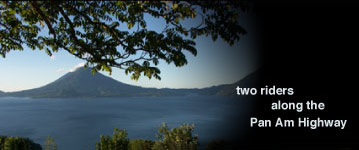
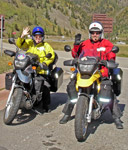
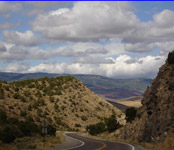
view corresponding gallery | previous entry | next entry
entry 22: peru 06/01/06
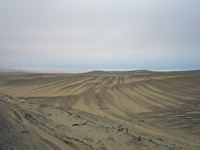 |
| Welcome to the worlds longest desert. Different days, same view. |
Entered Peru on the 6th of May. The border crossing was very low key but for some reason, persons holding foreign passports were delayed for several hours, which was not a good thing as we didn’t show up at the border until 1pm. Lynne passed the time by helping one of the border officials with his crossword puzzle and I spent the time working on our intercom system, which turned out to have water in one of the helmet connectors. We had great luck with the roads from the border all the way to Piura and we needed it. Lynne was in the lead as usual when we encountered our first herd of goats with 150 miles and three hours to ride before night fall. The first 50 mile stretch was a total goat crossing with a few surprise bulls thrown in for variety. But the roads were straight and we were able to do the 60mph (100 kph) posted limit most of the way. The new twist on the roads were the trikes, which are 100 or 125cc motorcycles with the rear tire replaced by an axle with two wheels and a covered bench. They can carry three passengers, or five propane tanks and one chicken coop, or any combination thereof. They ride halfway on the shoulder when on the highway, are restricted from city centers and drive any damn place they want to in the suburban and rural areas.
With night falling and heading into a town of 400,000, we lucked out when Lynne spotted a small sign for a hostel only a half block off of the main road. They were not setup for parking but in usual Latin American hospitality they let us park in their own private yard (which also doubled as their kitchen) – and gave us a room right next to where our bikes were parked. Piura is a fairly industrial town and although it had great Ceviche (fresh seafood soaked in onions, lemon and vinegar) it was not much of a tourist attraction - but still a nice city to spend a few days in. We did however, learn a lesson about electricity in Piura.The power receptacles are still 110 volts but we had to purchase a "triplet" to accomodate the larger prong on our plugs. We also found out that not all 110 volt outlets are really 110 volts. Our electric toothbrush had a meltdown after being plugged into an outlet for the night. That little luxury item won't be making the rest of the trip.
Our next four days of riding were like nothing we seen so far…in scope of landscape and human living conditions. Our pre-conceived notions of Peru were of a country filled with mountains, jungles and Inca ruins, which would be a correct perception of Peru - if you are riding in the mountains or through the Amazon Basin on the eastern side of the country. The west coast of Peru is…dry. We knew it was going to be four long days when we looked at the map and saw few towns with any significant population between Piura and Lima - but that didn't really begin to prepare us. We had no idea how vast and complete the desert was going to be. Delay #1 in leaving Piura was getting lost leaving the city itself - I relied on the GPS, ITM map and the city map given to us at the hostel – Lynne rolled her eyes and asked for directions as I was totally frustrated. When we finally got out of town we soon passed signs that warned of sand dunes ahead - and sure enough, the wind picked up enough so we had to lay our bikes into it. Wind and sand meant grit in teeth and I had to lengthen the distance behind Lynne as my wrists were getting peppered by sand. True to the sign warnings, sand dunes encroached upon the highway and speed zones often dropped to 45kph (about 30mph).
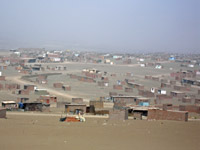 |
| A squatters village outside Piura. Haze always seemed to be present. |
It’s tough to feel bad about our riding conditions while riding by the huge strings of huts that pass as the suburbs of Piura - or further south where they are towns unto themselves. People wait on the roadside for a water truck to fill their 50 gallon plastic drums (all blue – I suspect government issued) and then they roll the drums through the sand back to their one room adobe homes. These people lead a life full of daily challenges that we take for granted. A truly humbling experience. Fishing is almost the sole industry along the coast and each small town we passed through was cloaked in the smells of fish drying, frying and rotting. We did find safe and fairly comfortable rooms along the way in the towns of Trujillo (got lost leaving that one too), Chiclayo and Barranca. Leaving the town of Chiclayo gave us an opportunity to personally meet the Policia Carreterra (Highway Patrol) who were not offering a friendly escort to our hotel this time. Parked on top of the hill on the side of the road, they stuck out their red flag and waved us over. We must have caught their attention when we passed a truck coming up the hill - but, it was a three lane road, all lanes were separated by a dotted white line and everyone used the center lane for passing. They asked us for our driver licenses and our vehicle import papers. We had been warned about handing over original documents to anyone, so we produced our not-so-real laminated copies. They indicated we were going to get tickets for passing the truck and also for not having our real licenses (spotted the copies right away). We stayed firm on not giving up our original licenses and explained in plain English that we had no idea what they were talking about. We did use some Spanish to let them know we would be happy to return to town and get this straightened out, which brought smiles to their faces and then they wished us a happy voyage.
Approaching Lima was a little intimidating as we had read that one-third of Peru’s population lives there. Also, of the 8 million inhabitants, a significant portion live in the outskirts, more or less as squatters…country folk who have come to find a better life and not yet found it. If it had not been for the six months of riding through towns with no street rules we would have totally freaked out riding through Lima. Busses and cars come within inches of your bike at 30mph. We have gotten pretty good at using our horns, which, when compared to some of the little Daewoo taxis around here - ours sound out fairly well. The Pan-American Highway comes in from the east and then curls around the old downtown on the north and then drops to the south on the west side. We made it that far and took the exit for Miraflores, a modern suburb and supposedly safer part of the city to stay in. We rode almost all the way to our hotel and then things took their usual confusing turn so we stopped to pay a taxi to lead us the rest of the way. The first three taxi drivers wanted three bucks to drive about six blocks (when a buck would have been plenty) but because we didn’t know WHICH six blocks, they knew they had us - well we paid the fourth guy the $3 and even he had to ask directions a couple of times along the way. We ended up in a really great location at the Los Palmas - very close to Kennedy Park, restaurants and shopping stores.
We spent several days there, where waking up to fog-filled streets and the sound of steel chisels on concrete was common. A lot of construction is still done by hand, with the rare jackhammer or concrete pumper truck making quicker work happen on bigger projects. Concrete with rebar and stone are used exclusively in building construction. Wood is used only for finish work and furniture. Telephone poles are also made out of concrete, which makes putting up flyers a little hard to do. We did take a taxi (five miles for the same $3) to downtown Lima to book a tour to Machu Picchu, and in great contrast to the burning rubbish and discarded plastic filled ditches of the outskirts - the city is very clean. We have noticed this in almost every city we have been to in South America. They take great pride in the places they live and work in and businesses wash their sidewalks every morning. Stores open at either 9 or 10 o’clock – close at 2 in the afternoon- and then re-open from 4pm to 8 or 9 at night. Most restaurants are open until midnight but we have never had to worry about that as we are usually back at the hotel by 10.
Lima was also the location of our first-ever earthquake. At about 10 o'clock one night, our bed shook and the closet doors opened and closed. Since we had never experienced one before, it took a minute to figure out what it was. They must be fairly common in the area though, as we had already noticed that most restaurants and shops have designated “earthquake safety zones” - the structural arches of the building themselves. The next morning we confirmed our suspicions - just a small one by local standards.
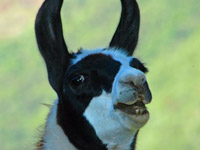 |
| You paid HOW MUCH for that hat? |
Next - some shopping. I am not quite the expert shopper as my soulmate - and this became even more evident while learning the ins and outs of garments made of the fiber from South American camels. The ancestors of these animals migrated from North America about 7 million years ago – and are now represented in Peru by two wild species, the vicuna and the guanaco; and two domesticated species, the llama and the alpaca. These animals, in particular the vicuna and the alpaca, have a very fine fiber which is sold at varying prices in the markets all around Peru . I learned two things right away. The first is that vicuna and baby alpaca (the first sheering) products are expensive. The second is that just because a label says it is doesn’t make it so. I now own a very nice polyester stocking cap, which I paid $3.50 for.
Los Palmas let us keep our bikes in their garage while we went to see Machu Picchu. We had decided to fly into Cusco instead of ride because the end of our trip is approaching and we still hold out hope for seeing the tip of South America. We arrived in Cusco (after one of many fog delays Limas is famous for) and were set up in a little hostel for two days while we visited some of the sites in and near town. The stop at the church Santa Catalina was very interesting because the Spanish built this church out of the stones of the Inca temple that was previously at that location. This re-occurring theme of the Spanish destroying temples to build churches is common throughout Latin America but there is some irony with this church. In 1950 a large earthquake hit Cusco, destroying a large part of this Spanish built church and the quake revealed large sections of the original Inca temple. You can now tour the temple and the magnificant walls that were built to withstand earthquakes, unlike the Spanish renovations. Another one of our stops was at an Alpaca factory, where I learned exactly how to spot the difference between polyester, alpaca mixed with polyester and the real thing. I now own a warm, mixed poly/alpaca sweater. This time my purchase was informed, but I am still too cheap to buy the real thing and needed something I could trash on this trip. Even down here a good sweater will run you $80 to $100 and grease has a way of finding my clothing.
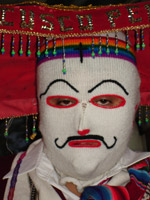 |
| Excuse me, sir. Could you please turn down the music? |
We took a tour bus with a few interesting stops half-way to Machu Picchu and spent the night in Ollantaytambo, where things closed up early, nights were very cool and the only outdoor night club was next door. What made it more than regular night clubs were the costumes that the dancers wore. From our second story vantage point we were able to watch the men, dressed in bright red capes and their faces covered with white stocking masks, and the women, who wore long dresses that flared out when they twirled. It was interesting to watch and listen for a while but by 1 a.m. enough was enough and Lynne went downstairs to talk to the manager, who then talked to the night club which then turned down the music for the last hour. So much for being fresh when climbing around Machu Picchu the next morning.
We boarded the train to Machu Picchu at 8am. The train is still the only way to arrive at the small village, Aguas Calientes, at the foot of the ancient Incan city. There are observation windows on the ceiling of the train so you could see the high mountains and canyon walls as the train wound its way down - yes, the ruins are actually at lower altitude than Cusco - a fact we just learned. It was a beautiful ride through the Andes. Upon arriving, we took a small bus up a dirt road full of switch-backs to the park entrance and found our guide.
Machu Picchu is a place full of mystery and questions. No one knows for sure why it was built, what its real name is (Machu Picchu is actually the name of one of the nearby mountains) or why it was abandoned. Archeologists are fairly sure that construction began in the 12th century and it was abandoned in the 16th century. It was a very well kept secret as the Spanish never knew of its location, which is why it was so intact when discovered in 1911 by Hiram Bingham. As you enter the park you walk around a small curve and then your sight is filled with huge stone buildings and row upon row of stone terraces. We have seen quite a few ruins on this trip (more than enough by Lynne's reckoning) and this one takes the Blue Ribbon! Evidence that construction was still underway when everyone left is clearly pointed out by stones cut but not put in place and the earthen ramps they used are still reaching for the next level on a temple. And one can only guess as to what the final construction would have looked like. Immense as the ruins are today there is still 30% hidden down below by forest and jungle.
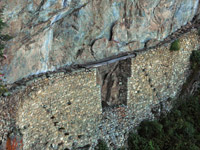 |
| Pretty ingenious, huh? Simply remove the wooden section and watch enemy fall.... |
There is one other way, other than the train, to reach Machu Picchu - and that is by hiking to it. The Inca trail is about 25 miles long and takes most people about three to five days to hoof it. Another trail that leads to this monument comes in from the backside, along a shear canyon wall. The Incas protected this rear approach by building the Inca Bridge, a stone bridge on a cliff with a removable wooden section…a sort of drawbridge. Pretty clever and very effective.
After six hours of climbing at high altitude we took a bus back down the hill to Aguas Callientes and checked into a comfortable bed at Gringo Bills. This little town serves not only as a base camp for M.P. but is also the unofficial pizzeria capital of the world. You would think that with all of the competition the pizza would be great, but with 99% of your customers in town for only one day, well, Pizza Hut has nothing to worry about from this town. Back on the train again, this time headed straight back to Cusco, which takes about five hours, the time was equally spent watching the valley scenery, a performing dancer and a fashion show...all taking place up and down the aisle of train car. We spent a few more days in Cusco to check out more of the museums (me) and shops (you know who). Then back on a plane to Lima, to recover our bikes and head south.
The coast south of Lima is very vertical at times and we were amazed at how the PanAm Highway, which hugs the coast, was ever built at all. Aside from encroaching sands, the highway is very well kept. We would be about fifty miles from nowhere when we would come across a single person sweeping the road with a hand broom because of a small rock fall. No truck or signs, just a single person with an orange vest. Or the two guys with a can of driveway sealer and a paintbrush working on the slightest of seams on the road. At times the road is at sea level for good dead whale watching and at other times you are on top of a 500-foot cliff with great ocean views. We had two great stops in southern Peru. The first one was at the Nasca Lines and the second was in the town Ica, in the heart of pisco country.
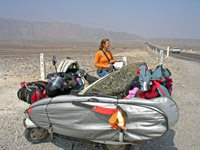 |
| Can you spot the moped in there? These little babies were loaded! |
You encounter the Nasca Lines - huge hieroglyphs drawn on the desert floor - directly along the PanAm. As with Machu Picchu, not much is known about the Nasca Lines, although most researchers agree they were created by three groups of peoples who inhabited the desert valley from 600 B.C. to 320 A.D. - and not by space aliens. How and why spiders and birds the size of three football fields could be drawn on the ground and only appreciated from 1,000 feet in the air is quite the question. The lines have been naturally preserved due to the heavy mineral content of the soil and the almost total lack of rainfall. We didn't feel like spending a day and $200 to fly over them in a plane but we did pay 30 cents each to climb a 50 foot tower to see "The Hands" (one hand only has four fingers) and a bird drawing. While stopped at the tower we met three riders from Montevideo, Uruguay heading north on two 125cc scooters loaded down with everything from surfboards to sunscreen. They made the whales look downright STREAMLINED in comparison! Hats off to them.
Our stop in Ica included a tour of a family owned pisco vineyard. Pisco is the national drink of Peru and has quite a kick to it. The process is partly like wine making - but more like hard liquor. Grapes are crushed by foot and then put in a press. The mash is then put into clay urns for a week to ferment and then are emptied into a large clay cauldrin. This is heated to a low boil and then the steam (Pisco alcohol) is put through a pipe that runs underwater to cool and condense the steam. The liquid is collected and then bottled. It is sold straight- 46% alcohol - or mixed with lime juice and something sweet and that is used to make a quick Pisco Sour - 23% alcohol. We also stayed at a pretty neat hotel that had friendly lambs cutting the grass outside our room.
Three days and 620 miles of riding from Lima brought us to Arequipa, a million-plus town located at 7,400 feet at the foot of two large mountain peaks, Chachani (19,000') and Pichu-Pichu (18,000'). It was here that we experienced our second earthquake in as many weeks. Is this some sort of sign? Arequipa was an OK place but it turned out we spent a lot of time at our hotel, El Balcon, because Lynne was bitten by a 24-hour bug that took a few days to recover from. The folks there were great and cooked up some chicken soup for her and let me wash the bikes in their driveway. The hotel was in an old colonial home that reminded us alot of our home in Denver. We weren't getting alot of sleep here, though. One night alone, we were awakend by noisy tourists, barking dogs, guards (stationed on the corner outside our room) whistling signals to each other, a 5:30am earthquake and early-morning construction traffic. The bags under our eyes are now 3-dimensional. Time to move on.
Our last stop in Peru was in the town of Tacna, the closest town to the Peru/Chile border. We are feeling the need to pick up the pace a bit. Winter is definitely coming. The nights are turning a little cool - the thermometer on the bike read 49 degrees when we left Arequipa and we've had to dig deep in the paniers to find our winter riding gear. So we're hoping for some warmer temperatures and a bit more diversity in scenery in Chile - we've had our share of sand and deserts!

Copyright © 2005 All content and photography are the property of Tom and Lynne Gefre.
Contact us if interested in publishing or reusing any material.